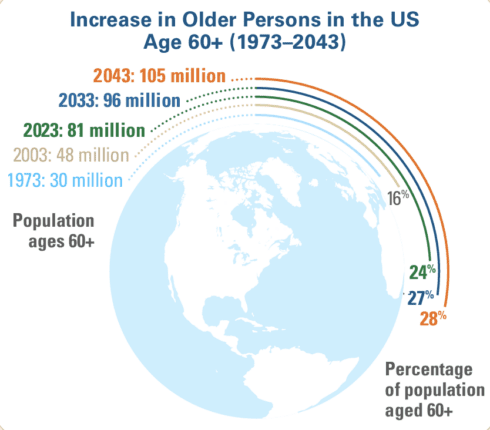-
REPORT LAUNCH | Population Trends and the Future of US Competitiveness

This article is adapted from “Population Trends and the Future of US Competitiveness”
Demographic issues intersect with a number of policy priorities on the congressional agenda, including the economy, immigration, health care and foreign policy, but how population trends influence policy outcomes is often overlooked or misunderstood. In a new report, we explore how population dynamics have changed dramatically over the last few decades, and what these changes mean for the economic and security interests of the United States.
Some population issues are an immediate and direct concern—as one sees clearly in the increased mortality rates due to the COVID-19 pandemic, or in spikes in the number of asylum seekers in the wake of conflict or instability. As all levels of government continue to prepare for such “shocks,” understanding demography is necessary for foresight exercises to anticipate them. Yet population dynamics are also important underlying drivers of long-term shifts. For example, demographic trends in fertility rates, mortality rates, and migration—the three building blocks of demographic change—affect the US labor market and its domestic consumer base.

The same situation holds true in other countries, and thus impacts the United States’ global economic competitiveness. If some countries with shrinking workforces, like many of those in Europe, do little to adapt to their new demographic reality (e.g., failing to reform low retirement ages and unsustainable entitlement levels), they could become less attractive economic partners for demographically younger states. If regions and countries with relatively larger and younger workforces, like sub-Saharan Africa or Indonesia, attract global capital and become strong economic hubs through partnerships with US competitors, the United States could lose its edge.
Population dynamics also affect national security and stability. The strategic environment will necessarily change as allies of the United States (including South Korea and Germany) and competitors (China and Russia), adapt to their own aging populations. For example, the massive surge in China’s labor force, which was a driver of its post-1980 economic growth and emergence as a global power, is now over as decades of declining birth rates catch up to that nation’s working age population. There is also mounting evidence of a relationship between youthful populations and civil conflict, with possible lessons to be found in the long US involvement in Afghanistan, which has one of the highest fertility rates and poorest human rights records in the world.
Finally, the energy and resource demands of the world’s 8 billion people—which vary greatly across regions—have implications for efforts to mitigate and adapt to climate change. Is it possible to achieve global climate goals and close energy deficits at the same time? Places such as India (the world’s most populous country) or sub-Saharan Africa (the only region of the world with a population growth rate over 2%) articulate this challenge. For instance, in sub-Saharan Africa, 600 million people lack access to electricity.
Population is a powerful dynamic. Yet US policymakers would be wise not to see any demographic trend as deterministic, whether at home or abroad. Doing so can lead to severely under- or overestimating the economic and national security effects that trends create. No demographic trend is inherently good or bad; national responses matter.
While the shift from high to low fertility around the globe is much maligned among those who portend economic collapse, the overall picture of global population is positive. We’ve made tremendous strides in health and longevity, stretching a life expectancy at birth of 31 years in 1900 to over 73 years today, adding what amounts to an “extra life” for people over the last century. The dramatic shifts over the last few decades mean that today’s population moment is different from anything we’ve experienced before. With the right investments, we can ensure the world stays on a path towards greater prosperity in the future.
“Population Trends and the Future of US Competitiveness” was made possible through the generous support of the Population Institute.
Jennifer D. Sciubba, PhD is a global fellow with the Wilson Center and author of 8 Billion and Counting: How Sex, Death, and Migration Shape Our World
Lauren Risi is the director of the Wilson Center’s Environmental Change & Security Program
Sarah B. Barnes is the director of the Wilson Center’s Maternal Health Initiative
Sources: Wilson Center, New Security Beat, OHCHR, UNCTAD, Statista, UN
 A Publication of the Stimson Center.
A Publication of the Stimson Center.




